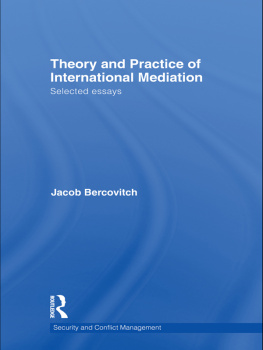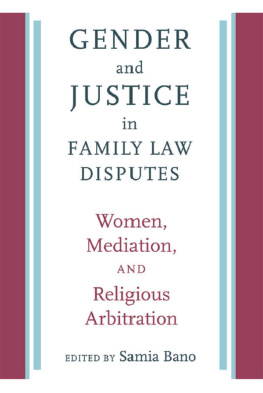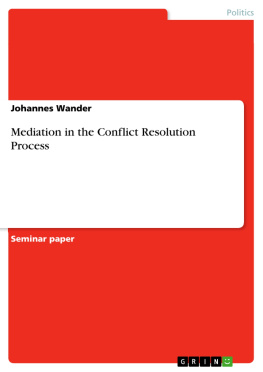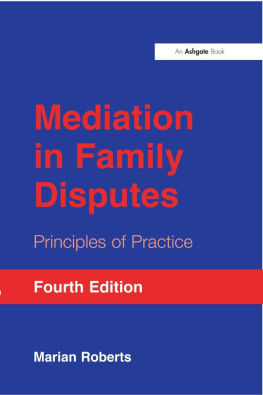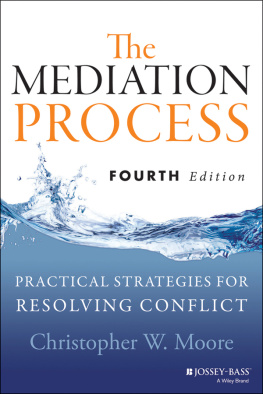HELPING PARENTS IN DISPUTE
To Bill and Kath
Helping Parents in Dispute
Child-centred mediation at county court
GREG MANTLE
Anglia Polytechnic University
First published 2001 by Ashgate Publishing
Reissued 2018 by Routledge
2 Park Square, Milton Park, Abingdon, Oxon OX14 4RN
711 Third Avenue, New York, NY 10017, USA
Routledge is an imprint of the Taylor & Francis Group, an informa business
Copyright Greg Mantle 2001
All rights reserved. No part of this book may be reprinted or reproduced or utilised in any form or by any electronic, mechanical, or other means, now known or hereafter invented, including photocopying and recording, or in any information storage or retrieval system, without permission in writing from the publishers.
Notice:
Product or corporate names may be trademarks or registered trademarks, and are used only for identification and explanation without intent to infringe.
Publisher's Note
The publisher has gone to great lengths to ensure the quality of this reprint but points out that some imperfections in the original copies may be apparent.
Disclaimer
The publisher has made every effort to trace copyright holders and welcomes correspondence from those they have been unable to contact.
A Library of Congress record exists under LC control number: 2001091616
ISBN 13: 978-1-138-73480-7 (hbk)
ISBN 13: 978-1-315-18698-6 (ebk)
Contents
Mediation and conciliation in various guises have been an accepted and welcome step in private law family proceedings for about 15 years in the Essex County Courts. In my judicial role I have, of course, taken a keen interest in the development of alternative dispute resolution over this period and am very pleased to be able to preface this important new work on the subject.
The research study on which this book is partly based progressed under the watchful and intrigued eye of a working party of family court welfare officers experienced in family mediation, a solicitor, judge and assistant chief probation officer. The research had been commissioned by Essex Probation Service who asked two very straightforward questions: how long do the agreements we broker last and how do the parents rate us?
The responding parents gave thoughtful and revealing answers. These have been analysed and categorised by Greg Mantle and themselves provoke further questions to those responsible for the mediation services offered. This comes at an important stage within family law proceedings as publicly funded litigation diminishes and the Family Court Welfare Service is re-aligned to CAFCASS. Being able to deliver a product that will be both attractive to users and cost effective will be a priority for the new service. As a result, this book offers an important and timely appraisal of current mediation practice, as experienced by parents who have been in dispute over contact or residence arrangements for their children.
Many of the study findings will be of interest to the architects and deliverers of the new service. For instance, there appears to be an overwhelming desire for an agreement which is enforceable; parents rarely seem to trust each other in these situations and it might be that the long held notion that agreement should mean no order may have to be statutorily re-visited. However, the overall value of the philosophy of mediation is reinforced and as one mother said:
If it can keep people out of court which is most anxiety provoking then it must be a good thing to try to do. I was terrified at thinking about going to court which I have never done in my life before.
Although the research is local to a relatively small court catchment area the lessons and questions raised will have a larger impact for all such services, whether in the private or public arena. The providers need to know what happens to settlements in the short and medium term, and the experiences of parents as they struggle to put agreements into practice.
Elizabeth Silverwood-Cope
District Court Judge
Spring 2001
Many people have helped in the writing of this book. In particular, I want to record my appreciation for the assistance and stewardship of Liz Cope, Sue Lowden, Silvia Ould, Jose Rowe, Alan Critchley, Phil Gould and Ray Shaffer. Lesley Dobre and Kate Atherton ensured that time was made available, and Gwynn Davis provided encouragement and generous welcome.
Many thanks are due to Jill, Erica, Isaac and Robbie, for their enduring support and patience, and to Avalon Associates of Chelmsford for final checking, formatting and preparation of camera-ready copy.
A very special debt is owed to the parents and carers who took part in the Essex study.
| ACOP | Association of Chief Officers of Probation |
| ADR | Alternative Dispute Resolution |
| BCS | British Crime Survey |
| CAFCASS | Children and Family Court Advisory Support Service |
| CSA | Child Support Agency |
| CPU | Conciliation Project Unit |
| EPS | Essex Probation Service |
| EFCS | Essex Family Court Service |
| FCDRC | Family and Community Dispute Research Centre |
| FCS | Family Court Service |
| FCWS | Family Court Welfare Service |
| FMA | Family Mediators Association |
| FPSC | Family Policy Studies Centre |
| GALRO | Guardian ad Litem and Reporting Officer |
| HMSO | Her Majesty's Stationery Office |
| NFM | National Family Mediation |
| ONS | Office for National Statistics |
Family mediation is a relatively new development, even when its immediate predecessor, family conciliation, is taken into account. Nevertheless, over the past three decades, the settling of disputes between parents by informal methods, rather than via more traditional, legalistic routes, has rapidly come to prominence. There are at least two crucial caveats to such statements: first, the emergence of family mediation in the West may, in fact, be traced back to much earlier times; and, second, mediation has been practised in other parts of the world as far back as the fifth century BC (Parkinson, 1997, pp.23).
Family dissolution is frequently associated with high levels of antagonism and conflict between parents, and the space to find mutually-acceptable arrangements, as to where children will live and when they will be able to spend time with their non-resident parent, may become considerably reduced. The importance of being able to reach a settlement on such matters is widely recognised, as are the consequences for children being exposed to parental conflict pre- and post-separation (Rodgers and Pryor, 1998, pp.4142). The need for some form of external intervention the provision of information, support services, counselling or dispute resolution via the courts, therapy or mediation is therefore readily apparent, although the focus in the UK has to date been mainly on providing specialist services to parents rather than to children. The direct involvement of children, affected by the separation of their parents, in the processes aimed at achieving agreement on residence and contact arrangements remains largely undeveloped, although there are indications that this state of affairs may be changing (Robinson, 1999).


